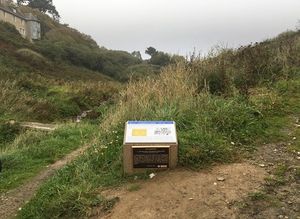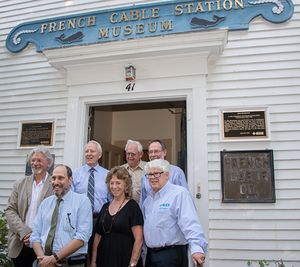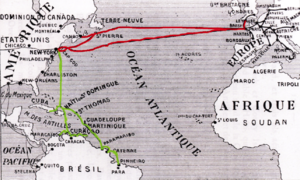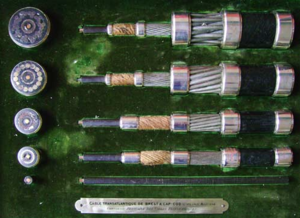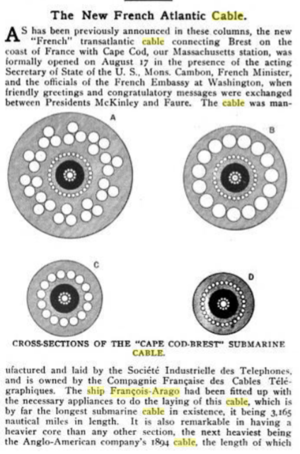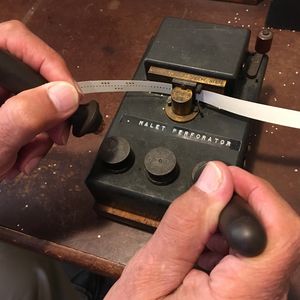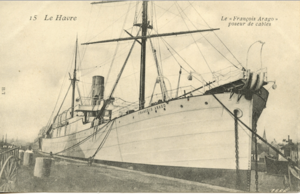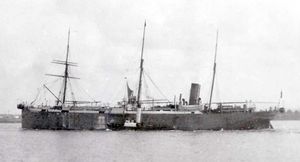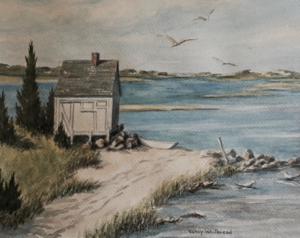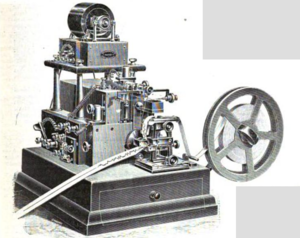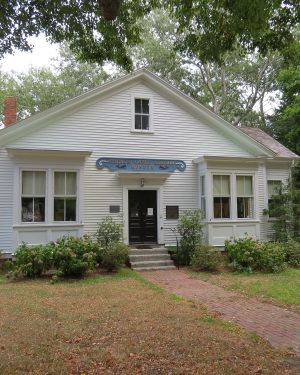Milestones:French Transatlantic Telegraph Cable of 1898
- Date Dedicated
- 2018/09/06
- Dedication #
- 191
- Location
- Orleans, MA
- IEEE Regions
- 1, 8
- IEEE sections
- Providence, France
- Achievement date range
- 1898
Title
The French Transatlantic Telegraph Cable, 1898
Citation
The submarine telegraph cable known as Le Direct provided communication between Europe and North America without intermediate relaying. In a remarkable feat of oceanic engineering, the cable was laid in the deepest waters of the Atlantic Ocean between Brest, France, and Orleans, Massachusetts. When completed in 1898 by La Compagnie Francaise des Cables Telegraphiques, it spanned 3174 nautical miles (5878 km), making it the longest and heaviest cable in service.
Le câble télégraphique transatlantique de Brest-Déolen à Orleans (Etats-Unis), 1898
Le câble télégraphique sous-marin le Direct assure la communication entre l'Europe et l'Amérique du Nord sans relais intermédiaire. Véritable prouesse d'ingénierie océanique, il est posé dans les eaux profondes de l'océan Atlantique entre Brest-Déolen et Orleans, Massachusetts. La Compagnie Française des Câbles Télégraphiques achève son installation en 1898. Avec ses 5878 km (3174 milles nautiques), il devient alors le câble le plus long et le plus lourd jamais utilisé.
Street address(es) and GPS coordinates of the Milestone Plaque Sites
At the Cape Cod location:
The French Cable Station Museum, 41 Route 28 at Cove Road, Orleans Massachusetts, 02653. USA. 41.787836, -69.987499
At Brest, France, the plaque is near the cable itself on the path below the former cable station 48.354854, -4.567289 (these are approximate. The exact address and coordinates to come).
, 41.7878355, -69.9874943
Details of the physical location of the plaque
At the Cape Cod location: The address is: The French Cable Station Museum, 41 Route 28 at Cove Road, Orleans Massachusetts, 02653. USA. The plaque will be attached to the building at the main entrance of the museum. It will be readily visible by the general public.
How the plaque site is protected/secured
The Cape Cod plaque will be attached and secured to the building and visible by the general public.
Historical significance of the work
1. INTRODUCTION
The French Atlantic cable project was a bold transatlantic submarine telegraphic cable project. Newspapers and English technical periodicals called it ‘the New French Atlantic cable’. Initiated in France in 1895, the work was successfully completed in 1898. The following document will describe the management, engineering, cable manufacturing, and the laying of this cable across the North Atlantic Ocean. Motives driving the project, its management and engineering requirements, as well as its execution, will be briefly described. The operating performance of this cable over its long history is also noteworthy.
While the history of submarine telegraphic communications is not within the scope of this document, it deals with one electrical engineering project that built Le Direct, the name given to a particular submarine cable that connected France and the United States. But before going any further, lets us explain some of the conditions that existed in early 1890s.
Abbreviations
- CFCT - La Compagnie Francaise des Cables Telegraphiques
- FTCC - French Telegraph Cable Company
- FCC - French Cable Company
- FCSM - French Cable Station Museum
- SIT - Société Industrielle des Téléphones
- nm - nautical miles
2. BACKGROUND
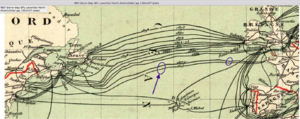
This chart illustrates the competition for business in the Atlantic cable telegraph market. In the early 1890s, there were 11 submarine cable systems operating between the United States and Europe, owned or controlled by the following enterprises: the Anglo-American Cable Company; the Direct United States Cable Company; the American Telegraph & Cable Company – whose cables were controlled and operated by the Western Union Telegraph Company; the Commercial Cable Company – whose cables were controlled by the Mackay (Postal) companies. There were small players, like the German Atlantic Company and the earlier French cable enterprise.
In 1895, at Pouyer-Quertier’s instigation, Compagnie Francaise du Telegraphe de Paris a New York merged with Society Francaise des Cables Telegraphique, which retained the nickname PQ in France and became totally independent of the British and American companies. On the American side, the company was known as the French Telegraph Cable Company, or FTCC. La Compagnie Francaise des Cables Telegraphiques (CFCT) acquired the business of its predecessor and took procession of the 1879 PQ cables – the Brest to St. Pierre, St. Pierre to Cape Cod, and St. Pierre to Canso Nova Scotia cable. This included the cable station at Brest, a repeating station at St Pierre, a station on Cape Cod with other facilities, and landing rights at Orleans Massachusetts on Cape Cod. CFCT had been marketing itself as a small independent Atlantic cable system serving special clients such as the New York Times. [1]
In 1894, two new premiere high-speed foreign cables, one nicknamed ‘Jumbo’, had landed in France, threatening their traffic. Those two cables were powerful motivators for CFCT to build a new French cable crossing the Atlantic directly to the United States. Eventually, at a Paris Convention on 2 July 1895, company officials and French politicians met to create an engineering development program that was signed into law, calling for the establishment, maintenance and operation of submarine telegraphic communications between France, North America and the Antilles. Signatories were:
- CFCT Administrator and Director: M. Depelley
- CFCT President: J. Caubet
- Minister of Commerce & Industry; and Post and Telegraphes: Andre Lebon
- General Director of Posts and Telegraphes: M. Jules de Selves.
Signatories took communications with the United States seriously as stated in the preamble of the Convention document [10 page 56]. A single cable could not guarantee the permanency of relations desired between the two countries. Financiers, bankers, diplomats, news service organizations, stock exchanges, needed more than a single line sectionalized at St. Pierre. It was unacceptable that citizens and businesses be at the mercy of the least mishap or failure of their eighteen year old PQ cable. These sentiments were reiterated by Mr.Turrienne, a company representative in New York City. His memo to the French Embassy dated 3 May 1897, explains why a second French submarine cable was urgently needed. [2]
“ . . . .insufficiency of the only cable which for eighteen years has connected Brest, France, and Cape Cod, Massachusetts, the present condition of which is such as to endanger the safety of its telegraphic communications with America.” He continues, “As I stated at the beginning, the cable has owing to long usage, suffered injuries which render it very defective. Long interruptions of telegraphic communications have been the result, especially during the years 1895 and 1896 and early in 1897. These interruptions, which lasted six months in 1895, eight months in 1896, and two months and nine days in 1897, have entailed not only a loss of business, which has been detrimental to the company, but also considerable expense for repairs. The establishment of a second cable is consequently a matter of urgent necessity. The French Telegraph Cable Company, having acquired the rights of the French, Paris and New York Telegraph company, now has the honor to solicit for the landing of its second submarine cable ..…”
Director Depelley in an interview with the New York Times 13 June 1897, spoke of national security issues. He admitted that the new French cable project was to insure absolute independence from the British cables for telegraphic communications between the United States and Europe.
“In case of war with Great Britain your sole means of communications with Europe will be by means of these French cables. . . France your sister republic, to which you are closely allied by ties of traditional amity, has opened her eyes to the danger which threatens you and her”. [3]
At the time the project was announced, England controlled the technology and owned most of the cables around the world. France wanted to maintain its small network for national security reasons. The English press dismissed the proposed new French Atlantic cable saying that France just wanted to thwart England’s monopoly [6]. One author [4] was critical of the project based on patriotism instead of sound engineering and economics. As we shall see, historical records give a different view, namely that the project encompassed broad principles of engineering and the economy of all resources. More importantly, the work satisfied human needs and the strategic objective to develop submarine cable technology in-house.
3. PROJECT REQUIREMENTS
The formal or legal document establishing the project was ‘Loi pour l’Etablissment, l’Entretien & l’Exploitation de cable entre la France, l’Amerique du Nord et les Antilles’. The law to establish, maintain, and operate the cable between France, North America and the Antilles. It was registered into law on 28 March 1898. See reference [14]. A condensed version of the law was published in l’Electrician, “Un Nouveau Cable Transatlantique Francois” [10]. Technical details are given in section ‘Cahier des Charges’ found on pages 81 to 88 of reference [14].
As shown on the map above, the requirements were: a. that a single new direct cable be installed between Brest and the United States. b. that the existing 1879 cable between Brest and St. Pierre be refurbished and maintained as backup. c. that a junction be installed connecting France’s cable network in the Antilles with the transatlantic lines.
The original contract described it this way:
“a poser entre Brest et le cap Cod dans le delai maximum de deux ans a partir de la date d’approbation, un nouveau cable absolument direct, c’est- a-dire sans atterrissement intermediare, et a grand capacity de transmission.”
i.e. “ .. to install a new cable within two years between Brest and Cape Cod, absolutely direct, i.e. with no intermediate landing or relaying, having a great rate of transmission.”
The best available technology (bat) and the best operating practices applied in the industry at the time would be employed. The cable would be designed to achieve a telegraphic speed of transmission equal to or greater than 300 signals per minutes. Upon completion, it would be tested for compliance with a siphon recorder ‘de Muirhead’.
The cost of the project was estimated at 20,000,000 francs. Its completion was two years. CFCT would retain ownership and operate both the old and the new systems. A yearly grant or subsidy amounting to 800,000 francs for 30 years was awarded, however if annual receipts exceeded a certain amount, then the subsidy would be forfeited that year. CFCT also increased its capitalization by 20,000,000 francs.
Cables were to be fabricated and installed by the Societe Industrielle des Telephones (SIT), which had the necessary experiences and resources. Manufacturing would take place at their existing plants in France. Cable laying would be the responsibility of SIT. A provision stated that the cable ship leading the expedition would to be owned by SIT and manned by French nationals. Chartering additional ships from England was permissible providing that a French SIT representative was aboard during the work. Chartered ships were to prepare and deliver cable laying documents, logs, scaled marine charts, and so on. All cable technology workers had to be French nationals, with the exception of those in the United States where their availability would be difficult. The contract agreement also addressed project delays, tour-de force exceptions, fines and penalties for cable interruptions, handling non-performances, approval of marine charts with proposed routing of cable, submitting cable samples for approval, in addition to reduced taxes on cablegrams transmitted by government agencies.
Provisions for repairing and maintaining new and old cables were also addressed. CFCT would set up two cable repair facilities, one for each coast. Cable stocks, tools, staff, had to be ready to mobilize within six hours. Each cable interruption was reportable to the government within 24 hours.
4. CABLE SPECIFICATION AND STATISTICS
Louis François Ferdinand de Nerville (1858-1931)
Francois de Nerville, worked for SIT and was responsible for engineering Le Direct. He wrote the technical specification, monitored cable fabrication, installation, and performed acceptance tests upon completion. His career included several French submarine cables as well as participation in international scientific societies. He received France’s Legion of Honor as Chevalier (Knight).
The cable was described in several articles [7,8,13] but the most authoritative one was Nerville’s own article [9]. He specified that the copper core consist of a solid central wire of 1.76 mm diameter surrounded by 12 wires twisted or spiraled, each of 0.61 mm. High conductivity copper was specified at 22 to 22.25 legal ohms for a sample at 24 deg C, 1 mm in diameter and 1 kilometer long. The core weighed 300/180 kg/nm (i.e., 300 kg, of copper conductor surrounded by 180 kg of gutta percha insulation per nautical mile). For deepwater sections, it was protected by steel armor comprised of 24 wires each 2 mil in diameter.
Which cable had the largest core? It was a well known fact in the cable industry that the Anglo-American Atlantic cable of 1894 was a brute, having a conductor core of copper 650 lbs. per nm., and gutta-percha insulator 400 lbs per nm. This was nearly double the weight of previous corresponding lines. The English cable was 650 pounds, which in metric is 294.835 kilogram. Nerville designed the French conductor core in metric to weigh 300 kg per nautical mile, slightly heavier than the other.
Different types of cable lengths were fabricated at SIT plants in Bezons and Calais during year 1896, 1897 and 1898. Their plant at Calais produced the central conductor core, called the ‘armature’ in French, beginning 19 October 1896 and finishing 20 August 1897. Lengths are tabulated below. An additional 300 miles of spare cable was produced during 1898.
Cable types & diameters:
- cable for deep sea type A 3095 27 mm (1.06 in)
- cable for deep sea type B 285 26 mm (1.02 in)
- intermediate cable type 302 33 mm (1.3 in)
- cable for coast water 13 46 mm (1.81 in)
- cable shore end 19 54 mm (2.13 in)
- Total 3714 miles
This figure of 3714 is the manufactured length, not the installed length. Nerville is clear about the installed length, i.e. that the installed or ‘pose’ length is 3174 nautical miles. Cable statistics:
- core weight = 300 kg copper, 180 kg gutta persha
- total laid cable length = 3174 nm
- total cable resistance = 5269 ohms
- total cable capacity = 1500 microfarad
Le Direct cable speed of transmission
As mentioned earlier, the specified minimum telegraphic speed or rate of transmission was 300 signals per minute; it was tested and found capable of 390 signals per minute, exceeding expectations. These tests were completed on 5 September 1898 using a Muirhead siphon receiver/ recorder believed to have been located at Orleans. Nerville wrote [9 ]
“…..390 signaux elementaires par minute. Pour la determination du nombre de signaux transmis par minute, on a compte les intervalles entre les letters pour un signal et les intervalles entre les mots pour deux signaux.”
…… 390 basic signals per minute. To determine the number of signals transmitted per minute, we counted the intervals between letters as one signal and the intervals between words as two signals.
Telegraphic speed through a cable depends on many factors, such as, skill set of senders and receivers, sensitivity of receiving devices, and the electrical characteristic of the cable which Nerville was interested in. With the use of a consistent system of measurement, higher speeds were achieved. In 1947, Rene Salvador said it this way:
“Incoming signals from London or Paris for transmission over the trans-Atlantic cables went directly to a regenerator which acted as an automatic sender transmitting at a steady 450 center holes per minute for Le Direct. Given the cable's length and the fact that transmission speed is inversely proportional to square of the cable's length, this was a remarkable achievement. It compared very favorably indeed with the Brest-Fayal cable which was only half as long, yet operated at just 660 center holes per minute.” [5]
5. CABLE LAYING EXPEDITIONS

Crossing the ocean with Le Direct was no simple task.The Atlantic topography includes the Mid-Ocean Ridge, Abyssal Plain, Abyssal Hills, Rift valleys, and seamounts at great water depth. Early mariners were aware of mountain ranges in the North Atlantic like the Faraday Mountains, Laura Ethel, Sainthill, Mount Chaucer, and Sable Island of the coast of Nova Scotia. On either side of the ocean, the continental shelf is up to about 160 km / 100 miles wide off the coast of Brittany but narrows to less than 65 km \ 40 miles off the Spanish shore. The edge of the shelf and the continental slope are dissected by numerous submarine canyons. Beyond the continental slope lies the Biscay Abyssal Plain, with depths of about 4,550 m / 15,000 feet which occupies about half the area of the bay. From north to south the Atlantic Ocean has a longitudinal ridge called the Mid-Atlantic Ridge in which depths vary from 300 to 400 meters / 984 to 1312 feet. This ridge spreads out at the 50 degrees north latitude. This is the region where the majority of Atlantic cables departed from England and Ireland (figure 1). On both coasts there are depressions in which the bottom is at the depth of 4000 to 6000 meters / 2.5 to 3.7 miles. Soundings have shown depths greater than 6000 meters / 3.7 miles.
The cable ships
Three cable ships were engaged to complete the job. Cable ship Francois Arago, was lead ship owned by SIT. The other two were charters from England, the Dacia and the Silvertown.
M.A. Rouillard (also spelled Rouilliard) (1860 – 1903) chief of the mission, led the expedition from aboard cs François Arago. He was the SIT engineer who designed the so-called Rouilliard’s ‘grappin de releve’ during 1897 and 1898. His innovative dredging system was credited for finishing the project on time.
Each cable ship (cs) completed the following portion of the work:
- cs Francois Arago: early April, 1897, shore end buoyed at Brest
- cs Dacia: June 5,6, to 7, 1897, landing the shore end at Orleans MA.
- cs Silvertown: August 5 to August 18, 1897
- cs Francois Arago: May 13 to June 9, 1898
- cs Silvertown: June 27 to July 31, 1898
- cs Francois Arago: August 1 to Sept 6, 1898
The route selected was south of the PQ 1879 cable. This would require sailing west out of Brest into the Bay of Biscay and into the Atlantic. The first major obstacle would be to get through the northwest coast of France into the Bay of Biscay. Cable ship Arago took it upon itself to work these more difficult waters, where the North Atlantic is known for its winter storms. It so happened that the year the project started was one of the most severe winter on record.
The Bay of Biscay lies between Brest on the Brittany Peninsula and the coast of Spain. The northern half of the bay is shallow but it drops very steeply away into the deep sea to a maximum depth of 4735 meter / 15,535 feet, or nearly 3 miles. Ships crossing the bay are subjected to heavy seas as full size Atlantic waves come crashing into the shallower waters. We know from entries in the Diary that cs Arago had great difficulties hooking up to the Brest shore-end cable. The greatest measured depth encountered by Le Direct was 4910 meters / 16,115 feet, or slightly over 3 miles.
The Cable Hut, Orleans MA
The Brest – Cape Cod Cable Diary was found in the archive of the FCSM.
The Diary covers the period 1 June 1897 to 7 Dec 1933. It was signed by Edward Raymond Barker, Chief Electrician, (from cs Silvertown); and M Roussel, Chief Expedition Engineer, (aboard cs Francois Arago).
Hut Instructions
- Ship will apply control test for insulation, cable being carefully freed for that purpose by Shore.
- Every four hours beginning at 4,8, & 12 am and pm, Shore will connect up to Mirror Speaking Instrument using (1) cell and will await Ship’s call. Ship will then give further instructions as to freeing and earthing for Ship tests etc..
- Ship will take off control current one minute before each of the above mentioned hours.
- At any convenient opportunity Shore will adjust his clock to that of Ship on receiving a ‘dot’ signal for that purpose.
- Should Shore fail to receive any call from Ship at any of the times specified, he will keep a lookout on Mirror for signals from Ship for one hour, and will also call Ship at short intervals, increasing battery if necessary, but not beyond a maximum of twenty (20) cells Leclanche.
- In the event of no signals being received from Ship on the completion of one hour, Shore will
- Earth cable for 15 minutes
- Free cable for 15 minutes
- Join up to Mirror for 30 minutes & so on.
That is to say, exactly at each full hour the cable will be earthed, and at each 15 minutes past each hour, the end will be freed for 15 minutes, and will be joined to Mirror during the remainder of the hour.
NB Earth connections to be direct to cable sheaths.
The Cape Cod Hut was manned 24 / 7 while Le Direct was being hauled across the ocean. The staff assigned to communicate with ships were either French or English speaking. Entries in the cable Diary were written in French or English depending on who was at the other end of the cable.
- For cs François Argo: French techs P. Lefreve & A. Lecoutre
- For cs Dacia & cs Silvertown: Mr. Raymond Barker & J. Jeffrey.
- Orleans staff: George S. Hall & Edgar H. Upham.
Major steps were recorded in the Diary ending when cs Francois Arago completed the last cable splice joining the Brest shore-end cable with the Cape Cod cable.
14 May 1897 . . . cs Dacia sailed from England to Calais to pick-up the Cape-Cod shore-end cable, then finished the work.
May to August 1897 . . cs Silvertown is on the coast of Cape Cod working its way eastward, to lay various lengths of coastal and intermediate type cable.
April to May 1897 …cs Francois Arago sailed from Calais westward to find the cable buoy dropped off by Silvertown. Note that the cable ships are progressing eastward with their heavy load of cable, from Cape Cod to Brest, not the other way around. The whereabouts of cs Arago for the rest year is unknown.
1 June 1897 … Looking for Dacia with 183 miles of new cables aboard.
- 8 am Dacia cast anchor one mile off entrance to Nausset Harbor.
- 9-10 am Mr Roussel Chef de l’Expedition, and Robinson Chief of the Cable Laying Staff came ashore to look over the landing ground. Roussel and Robinson tried to get back on board their ship that night but couldn’t because of rough seas.
June 1897 …. 6.20 am. Osborne, Roussel and Robinson go to Barnstable to meet the harbor fee Collector. A few days delay waiting for approval to land cable and pay local bond. Meanwhile, in Washington DC, there’s flurry of letters between lawyers, the French Embassy and the US State Department about getting approval to land the cable. Meanwhile, cs Dacia had already installed 1000 feet of the heaviest armored cable on the beach before sailing back home to England.
7 June 1897 …. ship Dacia has laid all cable on board. Ship says seal end then says goodbye.
Entries in the Diary ceased at that time because cs Francois Argo was on the coast of France held up by major accidents and equipment breakdowns. Bad winter gales throughout the winter of 1897 – 1898 caused major delays. Meanwhile the Silvertown continues to wait in Calais. Nerville wrote that cs Arago tried to leave the port of Calais twelve (douze) times but was pushed back each time. Finally the weather cleared and cable work resumed. The final steps of this long, epic journey were recorded in the Diary and are included in the following three pages. The final splice was made aboard cs Arago at approximately 4200 km / 2600 miles from the American shore. The cable was then released temporarily to others for performance tests and presidential greetings.
Since cable laying was a cooperative bilingual effort, journal entries were in both languages: French when working with cs Arago, and English with cs Dacia and the Silvertown.
15 August 1898
- 2.46 Going to do splice. Stay near the mirror.
- 5.51 Splice is terminated. Will lay five miles then will test.
- 6.3 Begin tests; continue
- 7.51 The ship removed its current & ties up end of cable and places it on buoy. Test cable, resistance, data unclear.
- 8.46 The watch is interrupted. .. hold for 24 hours.
16 August 1898, ship is 2082 miles from Cape Cod
- 2.40 (NY time) 7 morning. Deolen communicates with Arago. The watch at the mirror resumed. ..?
- 2.32 (ship time) Oscillation brisk? at the mirror.
- 12.34 Call the ship.
- 12.35 Ship’s occupied with its work.
- 12.45p Ship. Lefevre watch Sunday night. In 3 hours Fournier will call you.
- 12.54p cable on board.
- 1.34p ship calls
- 1.39p ship says ‘au revoir’ and begins splicing
- 3.0p Notifies Brest that the watch at Deolen n will call Cape Cod by cable at 6.40 tonight (Paris time).
- 6.25p Observation at the mirror
- 6.30p call from Deolen
- 7.30p Deolen says transfer the cable over to the cable company for four days inauguration.
- 7.55p The cable is connected to the underground line of the station and Mr. Osborn took possession of the new cable.
17 August 1898 See Brest Diary
- midnight The cable is at the disposal of the Society des Telephone.
18 August 1898
- 4.58 Watch at Deolin (Mr. Lefevre and Mr. Fournier) take measurements.
18 August 1898. Deolin say begin watch at 5 tonight Paris time, Saturday 20th.
20 August 1898
- 11.40 Resumed watch with Lefevre, Lecontre, Hall and Upham. Exchanged signals for last half hour.
22 August 1898
- 4.21 to 4.51 Communication with Deolen interrupted.Cable resistance 4370 instead of 4546. Watch continues without incident.
24 August 1898
- 2.46 Called ship.
- 3.25 Ship says lifting cable near fault. Ship says at 2626 miles from Cape Cod. Searched four hours with watch and signaling ship.
- 6.15(ship) Last signal with ship. Communication with ship interrupted . Watch continued.
31 August 1898
- 4.50am Brisk movement - unclear
- 4.58am Ship calls
- 5.8 Ship says fault has been lifted; will make splice: cable broke while lifting it last 24 August.
- 11.5am Ship says splice finished. Ship will lay 13 miles. Fault at 2613 from Cape Cod.
- Noon Ship says laying cable; begin continuity.
- 3.5 Placing cable on buoy; watch in six ? hours.
- 3.9 Good-bye. Single watch by Lefevre .. 4.6 megohms absolute.
- 9.30 ny Restart watch.
1 September 1898
- 7.40 ny Message from Brest “have ship”.
- 2 September 1898
- 3.42am Communicating with ship
- 5.46am Ship picks up buoy from the Cape Cod end.
2 September 1898
- 10.50 ny Call ship
- 11.33 Ship says will make final splice. Brest will call you in four hours.
- 11.43 Terminated with ship.
- 3.41 Deolen calls.
- 3.45 Ship says isolate for 20 minutes
- 4.46 Deolen good-bye till 8 new york time.
3 September 1898
- 8am Waiting on watch. Deolen waits for company representatives to do tests. Mr. Fournier does same.
4 September 1898
5 September 1898
- 9.16 Deolen says to isolate for two and half hours. Tests for isolation and capacity in the presence of Mr. de Nerville and Godfray.
- 11.50 Deolen - ground cable for 30 minutes.
- 1 Deolen says will repeat the series of tests; please isolate until tomorrow at 4.40 Paris time. Good night.
5 September 1898
- 11.31am Deolen says to isolate for 20 minutes.. .
- 12.01pm Deolen says that tests are finished. What remains is the transmission speed tests. I will turn cable over to Mr. Godfroy and will make you take part in these tests.
- 12.11pm Deolen says they will relay with Brest and after responding to the station you can establish communications with them.
- 12.56pm I have Brest. Their watch replies give us Cape Cod station.
- 1 pm The cable is connected with Orleans (CC).
That was the last entry.
6. OPERATIONS
CFCT had offices in major European cities as shown on figure 2. These were connected to a network with links to all foreign telegraph administrations. For example, in 1903, a major news story from Rome to New York that once took five or six hours, could be transmitted in less than an hour. This involved a transmission by telephone to The Associated Press office in Rome, dispatched by telegraph to Paris, relayed to Brest, and cabling by the FCC to Orleans, then retransmission by telegraph wires to their office in New York, hence to the office of The Associated Press in the Western Union Building on Broadway into the New York Times.[12 ]
Company offices in New York were then located at 34 Broad Street, Pulitzer Building, 1 Mercer Street, 5 East 14th Street and in the Union Dime Savings Bank. Messengers were available for pickup and delivery of cablegrams.
CFCT’s physical plant in the United States was described in trade journals as well as other publications. The organization owned two cable systems: the Franco-American system and the South-American system, for a total of 12,089 nautical miles of submarine cable. But only the former division is addressed here. According to 1904 business reports, their Franco-American system consisted of these cables:
- Deolen, near Brest (France) to St. Pierre: 2,361 nm 1879
- St. Pierre to Cape Cod Massachusetts 829 nm 1879
- St. Pierre to Canso (Nova Scotia) 258 nm 1879-80
- Brignogan (France) to Penzance (Cornwall) 108 nm 1880-98
- Deolen, near Brest (France) to Cape Cod 3173 nm 1897-98
- Cape Cod to New York (Manhattan Beach) 324 nm 1899
Brest and Deolen
Operating methods and procedures are extracted from Rene Salvador’s article [5]:
“Brest messages were transferred manually from the trans-Atlantic cables to the lines to London and Paris. The receiver was a device known as an ink siphon recorder. The operator read the tape produced by the siphon recorder and copied it on a typewriter. The typewritten message was then passed to the telegraph operator connected to Paris via the French Telegraph Network operated by Baudot (the code) or to London via Porthcurnow.
At first, transmission over the submarine cables was by operators using handkey senders. Later punched tape and automatic senders offered a more uniform transmission rate.
In 1922, PQ decided to centralize submarine cable operations at Deolen. The new station, built on the site of the former cable hut, was commissioned in 1925. It was superbly situated. The Superintendent's house was on higher ground offering magnificent views over the Iroise Sea, the local name for the approaches to the narrows leading to Brest harbor.
The new station featured more modern equipment and direct connections between the submarine cables and the telegraph network linking Deolen to PQ's Paris office via the Deolen-Brignogan landline and Portcurnow. By this time, the latest receiving equipment at each end of the trans-Atlantic cables was the Heurtley magnifier (a type of hot-wire amplifier). This produced a signal strong enough to drive a regenerator which, as the name implies, accurately regenerated each dot, dash or space in the correct sequence. Incoming signals from London or Paris for transmission over the trans-Atlantic cables went directly to a regenerator which acted as an automatic sender transmitting at as steady 450 centers holes per minute for Le Direct.
Given the cable's length (and the fact that transmission speed is inversely proportional to square of the cable's length) this was a remarkable achievement. It compared very favourably indeed with the Brest-Fayal cable which was only half as long, yet operated at just 660 center holes per minute.
The new equipment at Deolen also made it possible to upgrade Le Direct from simplex to duplex operation (i.e., simultaneous transmission in both directions).The received signals being very weak, duplex operation required a bridge arrangement which, in turn, called for an artificial cable to balance the actual submarine cable.
The cable's RLC characteristics were duplicated using Muirhead boxes. A 1450-F cable required an artificial cable comprising 60 to 70 Muirhead boxes. The new equipment was installed in a very large room in the station's basement. Mr. Bernard, the superintendent, became very adept at quickly readjusting the artificial cable each time repairs were made at sea.”
Orleans, Cape Cod and New York
The Orleans Cable Station emulated the telegraphic operations established by Deolen. Transmitting and receiving instruments at those locations were of similar types, English made and commercially available. Operating methods, procedures, abbreviated codes, savy short-cuts, all were thoroughly understood by operators at both ends of the cable.
Because Le Direct signals were incredibly weak, had they been connected directly to a long distance siphon recorder, would have given a very low speed. To move things along, Le Direct signals were amplified with a ‘mechanical’ type amplifier, the Heurtley magnifier, popular in that industry for a long time.
At the beginning, submarine cable messages were sent manually with hand operated sending devices: moving a three position hand key to the left or right or centered, caused a change in the polarity positive or negative or ground zero, signaling a dot or a dash or a space. As business expanded it became clear that some means of automatic transmission was required. Lack of uniformity between signals, individual idiosyncrasies, became a problem. As traffic increased, the need for speed while maintaining consistency became apparent. So the automatic sending machine called the Muirhead transmitter was used. Similar to a punched tape machine, small holes were perforated in the center of a paper tape acting as feedholes which guided or advanced the tape through the transmitter. The dots and dashes were inscribed with larger holes punched either above or below the feedholes (centerholes). The Kleinschmidt perforator was introduced in 1916. The operator stood in front of an alphabet keyboard which would punch codes on the paper tape. This tape was then fed to an automatic transmitter connected to Le Direct.
Many ideas were tried to amplify the weak signals obtained from a long cable. The Heurtley hot-wire magnifier, a weird looking mechanical amplifier, manufactured by Muirhead was the popular choice. Much later in 1928, a photo-electric amplifier was developed by FTCC’s engineering staff to eliminate some of the problems with the Heurtley amplifier and to satisfy their particular conditions. Nothing much is known about this device except that it was used at French cable stations. An artifact is on display at the Orleans museum.
In addition to its transatlantic cables, the company’s physical plant in the United States in 1912, consisted of 1880 km / 1,170 miles of landlines on 500 km / 310 miles pole lines. Landlines were the preferred way to connect the Cape Cod station to the office in New York City. Early plans calling for a Brest-Cape Code - New York submarine circuit never materialized. The 1899 cable extension, from Cape Cod to Gotham City, laid by cs Francois Arago was rarely used except for emergencies, as confirmed by the general manager in 1912:
“The cable from Cape Cod to New York, 525 km / 325 miles in length, is an emergency means of communications between these points, when the land-lines are temporarily interrupted through storms or accident. No land messages, that is, telegrams between points in the United States are transmitted by us. Telephone lines are also leased from the New York Telephone Company, connecting branch offices in New York City and the cable housed at Manhattan Beach or Coney Island, with the company’s head office on Broad Street.”
Company landlines from Orleans to New York began the journey along the railroad track to Attleboro Massachusetts, hence on pole lines to Providence, Rhodes Island, Hartford Connecticut, Bridgeport, to Mott Haven, New York, and Manhattan. Finally, underground wires leased from Western Union to get into their main office. A so-called ‘PQ’ man was stationed in each town to attend to telegraph relays. The company had linesmen for repairs, especially busy following winter storms. Landlines became obsolete in 1932 when the company made arrangements with AT&T to lease telephone circuits between New York and Cape Code. This eliminated manual relaying and eliminated landline failures, also making it feasible to upgrade to AT&T’s latest technologies.
Cable Repair Facilities in Halifax
As required by the Convention, CFCT established its own cable repair facilities at Halifax harbor to service the west side of the Atlantic seaboard. In 1916, they built a two story brick building along French Cable Wharf for dispatching cs Edouard Jeramec. CFCT’s name was engraved. It is still visible on the front of the building which is now occupied by the government.
7. POST WW2 RESTORATION
On June 1940, the German army occupied Brest, shutting down and the Brest - Cape Cod submarine cable and others. Following extensive repairs, le Direct was restored, becoming operational in 1952. Rene Salvador worked on the restoration of Le Direct and wrote about it. The article was published by the IEEE. Parts extracted [5]:
“ It took much longer to repair "Le Direct" as it was broken and damaged in many places including at least three at depths between 4,000 and 5,000 meters. Repair work was undertaken by the Pierre Picard. Built in France in 1913 and operated by PQ as the Edouard Jeramec, she had been sold to All America Cables in 1929. In 1946 she was repurchased by the French PTT administration and renamed the Pierre Picard. Work began on the western side of the Atlantic. The Pierre Picard left Le Havre in January 1949 and began repairing the shallow-water section (down to 200 m) on the continental shelf off Cape Cod and out to about 200 nautical miles. Ten or more breaks were repaired in this section including one very close to the Orleans Cove shore-end. In May 1949, a new shore-end was laid. The first deepwater break, south of Halifax, Nova Scotia, was not due to natural causes. In 1941, the British had decided to use the Brest-Cape Cod cable to provide an additional link between Halifax and Porthcurnow. The western derivation had to be abandoned due to the threat posed by German U-boats. When the Pierre Picard arrived on the scene in 1949, neither the PQ management nor the French PTT administration was aware of what had happened. During a stopover in Halifax, the officers of the Pierre Picard had the immense good fortune to meet those of the Cyrius Field. Just before they were scheduled to set sail, the officer of the Pierre Picard learned what they needed to know, making their task considerably easier than it would other side have been.
The Pierre Picard returned to Brest in September 1949 after completing all necessary repairs between Cape Cod and a point in the mid-Atlantic north of the Azores. Much work remained, however. The author remembers this eight month expedition particularly well. Up to 35 days were spent at sea between ports. As a young engineer, I assisted Mr Mangon who had been a senior cable engineer with PQ before the war. It took two more summer expeditions to finish the job. Given the cable's susceptibility to twisting and kinking and the weather in North Atlantic, summer was the only season deep-sea repairs could be undertaken with a fair chance of success.”
8. CLOSING
The company in Orleans remained dormant until 1952 when it was re-opened running Le Direct for a few more years. The telegraphic cable was finally abandoned in 1959 because of better, faster, and cheaper communication alternatives. On 24 November 1959, with the coming of new coaxial high quality voice grade cables across the Atlantic, the Cape Cod station was permanently closed. In 1971 a local group in Orleans, Massachusetts purchased the property and established the French Cable Museum. The interior contains all the original cable terminal operating equipment which has remained untouched from the original positions.
Acknowledgement
I would like to recognize Phillip Cousins and Joseph Manas executive board members of the French Cable Station Museum for contributing to this document. Thanks for helping with archive records, photographs, reviews, and constructive comments. Gilmore Cooke, 1 September 2016.
Features that set this work apart from similar achievements
Not Applicable
Significant references
- H. Haynie, “Submarine Telegraphy A New French Transatlantic Cable,” Scientific American Supplement, Sept 25 1897, p 18124.
- Mr. Turrienne memo to the French Embassy, 3 May 1897, pages 1, 2.
- “Interview with M. Depelley on New French Cable,” The New York Times, June 13, 1897.
- Karl D. Stephan, “Liberte Egalite Telegraphie: The French Cable Station In Orleans, Massachusetts,” IEEE Antennas and Propagation Magazine, Vol. 37, No. 5, Oct 1996.
- Rene Salvador, “A Short History of French-Transatlantic Telegraph Cables from French Viewpoint,” IEEE Instrumentation and Measurement Society Newsletter, Spring 1995.
- “The New French Atlantic Cable,” The Electrical Engineer, Aug 26 1896.
- “The New French Atlantic Cable,” The Electrical Engineer, Nov 10 1898.
- “The New French Atlantic Cable,” The Electrician, 19 Aug 1898.
- FG de Nerville, “Nouveaux cables de la Compagnie Francaise des cables Telegraphiques,” Annales Telegraphiques, Sept.- Oct.1898, pp 383-392. L'Electricien; revue in#138075C
- “Le Nouveau Cable Transatlantique Francais,” l’Electricien Revue Internationale de l’Electricite, Jan 4 1896, pp 56-59. La Lumière électrique
- H. Larose, “Les Dragages de Cable Sous-Marin par Grands Fonds,” l’Eclairage Electrique, 10 Aout 1901, pp 197- 206. #1377DEC
- “Remarkable Telegraph Service From Rome,” The Telegraph Age,1903.
- 2 sheets (1, 2), “Les nouveaux cables sous-marin francais,” Le Genie Civil,1898. Annales télégraphiques #13808D4
- “Loi pour l’Etablissment, l’Entretien & l’Exploitation de cable entre ….l’Amerique du Nord…Annales Telegraphiques,” 1897-1898, pp 62-91. https://books.google.com/books?id=9RFLAAAAYAAJ&pg=PA225&dq=les+grappins+rouillard&hl=en&sa=X&ved=0ahUKEwjO-9mO483OAhWFNiYKHcvVAz4Q6AEIHjAA#v=onepage&q=les%20grappins%20rouillard&f=false
- “Les Grappins Rouillard pour le dragage des cables sous-marins,” l’Electricien 14 April 1900, pp 225-227.
Supporting materials
Providence Section letter of endorsement and financial support will be emailed to R Colburn separately.
Letter of endorsement and acceptance by the French Cable Station Museum to be emailed separately.
Archive
“Brest-Cape Cod Diary, June 1897 – 7 Dec. 1933”.
French Cable Company,
FCSM archives, Orleans, Massachusetts.
Howard T Gould, unpublished bound memos entitled “Operational Information,” from 1979 and 1980, FCSM archives, Orleans Massachusetts
Web
History of the Atlantic Cable & Submarine Telegraphy by Bill Burns, http://atlantic-cable.com//
French Cable Station Museum Orleans, http://www.frenchcablestationmuseum.org/museum-history.htm
Books
La grande aventure des câbles télégraphiques transatlantiques à la pointe de Bretagne. Locmaria Patrimoine, Paris, 2016.
Rene Salvador, Gerard Fouchard, Yves Rolland, Alain Paul Leclerc, De Morse a l’Internet,150 ans de telecommunications par cables sous-marins, La Seyne-sur-mer, 2006.
WS Darling, “The French Cable Station Museum,” Orleans, Massachusetts,1988.

